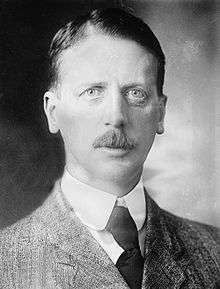Phillips Lee Goldsborough
Phillips Lee Goldsborough I (August 6, 1865 – October 22, 1946), was a Republican member of the United States Senate representing State of Maryland from 1929 to 1935. He was also the 47th Governor of Maryland from 1912 to 1916 and Comptroller of the Maryland Treasury from 1898 to 1900.[1][2]
Phillips Lee Goldsborough | |
|---|---|
 | |
| 47th Governor of Maryland | |
| In office January 10, 1912 – January 12, 1916 | |
| Preceded by | Austin L. Crothers |
| Succeeded by | Emerson C. Harrington |
| United States Senator from Maryland | |
| In office March 4, 1929 – January 3, 1935 | |
| Preceded by | William Cabell Bruce |
| Succeeded by | George L. P. Radcliffe |
| Comptroller of Maryland | |
| In office 1898–1900 | |
| Governor | Lloyd Lowndes Jr. |
| Preceded by | Robert Patterson Graham |
| Succeeded by | Joshua W. Hering |
| Personal details | |
| Born | August 6, 1865 Princess Anne, Maryland |
| Died | October 22, 1946 (aged 81) |
| Political party | Republican |
| Spouse(s) | Ellen Showell |
| Children | 3 |
Early life and career
Goldsborough was born in Princess Anne, Maryland and was educated in public and private schools. While working as a clerk for the United States Navy, he studied law and was admitted to the bar in 1886, commencing practice in Cambridge, Maryland soon thereafter. He also held an interest in banking. In 1893 he married Mary Ellen Showell (c. 1865 – 1930) and they had two sons: Brice W. Goldsborough; and Phillips Lee Goldsborough II.
In 1891 and in 1895, Goldsborough was elected state's attorney for Dorchester County, Maryland. In 1897, he was elected to the position of comptroller of the treasury of Maryland, but was defeated for reelection in 1899 by Dr. Joshua W. Hering. As of 2018, he is the last Republican to have served as Maryland Comptroller.
He was appointed collector of internal revenue for the district of Maryland in 1902 by President Theodore Roosevelt and later by President William Howard Taft.
Governor of Maryland
Over time, Goldsborough built a large base of support in the state, which encouraged him to run for Governor of Maryland in 1911. He defeated Democratic challenger Arthur P. Gorman, Jr., becoming only the second Republican governor in state history up to that time.
Goldsborough's tenure as governor saw a great deal of education reform, including the appointment of school boards and teacher certification. It was also during his tenure that the state purchased the Maryland Agricultural College, which is now the University of Maryland, College Park.

United States Senate
Goldsborough sought the Republican nomination for the Class I U.S. Senate seat from Maryland in 1916, but was defeated in the Republican primary by Joseph I. France. He left politics afterwards and resumed his law practice in Cambridge, and also became president of the National Union Bank.
When Republican Herbert Hoover was elected President of the United States, Goldsborough again sought the same senate seat in Maryland. He was elected to the United States Senate in the election of 1928, defeating incumbent William Cabell Bruce.
Later career and death
In 1934, he was not a candidate for re-election to the senate, but instead ran again for Governor of Maryland. He lost in the Republican primary to Harry W. Nice, who went on to win the general election.
President Franklin Delano Roosevelt appointed Goldsborough to the director's board of the Federal Deposit Insurance Corporation in 1935. He served in that position until he died in 1946 in Baltimore, Maryland, and is buried in the old churchyard of Christ Episcopal Church of his hometown of Cambridge.
References
- "Phillips Lee Goldsborough (1865–1946) Biographical Series; Governor of Maryland 1912–1916, U.S. Senator 1929–1935 (Republican)". Archives of Maryland, MSA SC 3520-1478. Maryland State Government. August 10, 2001. Retrieved September 11, 2018.
- White, Jr., Frank F. (1970). The Governors of Maryland 1777–1970. Annapolis: The Hall of Records Commission. pp. 245–248. ISBN 978-0942370010. Retrieved September 11, 2018.
- United States Congress. "Phillips Lee Goldsborough (id: G000262)". Biographical Directory of the United States Congress.
| Party political offices | ||
|---|---|---|
| Preceded by George R. Gaither, Jr. |
Republican nominee for Governor of Maryland 1911 |
Succeeded by Ovington Weller |
| Preceded by Joseph I. France |
Republican nominee for U.S. Senator from Maryland (Class 1) 1928 |
Succeeded by Joseph I. France |
| Political offices | ||
| Preceded by Robert Patterson Graham |
Comptroller of Maryland 1898–1900 |
Succeeded by Joshua W. Hering |
| Preceded by Austin L. Crothers |
Governor of Maryland 1912–1916 |
Succeeded by Emerson C. Harrington |
| U.S. Senate | ||
| Preceded by William Cabell Bruce |
U.S. senator (Class 1) from Maryland 1929–1935 Served alongside: Millard Tydings |
Succeeded by George L. P. Radcliffe |
